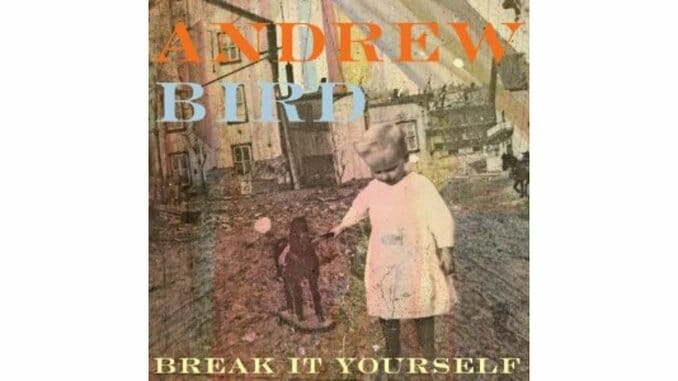
Last year, Andrew Bird contributed a cover of the Kermit the Frog classic “Bein’ Green” to a Muppets tribute album. Elsewhere, he partnered with sculptor and instrument maker Ian Schneller on a performance and installation involving speakers made from recycled newspapers and dryer lint. He follows the same definition of “quirky” that people use for Wes Anderson movies — his interests are idiosyncratic, to be sure, but somehow the definition feels too overreaching, like using Instagram and “hipster” in the same breath. (Bird, this week, actually used Instagram to promote the album, so, there you go.)
Bird’s seventh solo album, Break It Yourself, will likely set itself up for those dreaded descriptors, from the titles onward. There are references to Greek mythology, to horrible international tragedies. There’s a fake palindrome (how meta!). There is, per usual, quite a fair amount of whistling. It is, however, a bit more reserved than the earlier Birds (groan). Long gone are the rapturous flourishes of “Fake Palindromes” and even further the weird but awesome swing revival phase in which he participated as a Squirrel Nut Zipper. What we’re left with is a guy, with a violin, an embouchure of pure steel, and a set of sweet, gentle (though occasionally a bit too much so) jams that will come to you with good intentions. Break It Yourself greets its listener like a friend-turned-lover making the first move: sitting on opposite ends of the couch, inching closer and putting its arm around you and by the end, you’re curled up together, sleepy but overall content.
From the outset, it seems that “sleepy” will be the decisive adjective of this album. “Desperation Breeds…” a song in which Bird sings about the plight of our ecosystem and rapidly declining bee populations, even begins on a downbeat. The lack of urgency about such an important issue to human survival seems a bit odd, but as with quite a bit of this album, Bird’s songs start to peek out of their shells a third, halfway through, and come around the corner with vocal whinnies or stunning vibratos or gorgeous swells that make it worth sticking around.
“Danse Caribe” is like one of Gauguin’s Tahiti paintings: a colorful and nostalgic scene painted from the perspective of the visitor with an easy-going feel and fiddles and whistles standing in for calling seabirds. Around two-and-a-half minutes, Bird gets some wind in his sails and the tempo picks up with a gleeful jig. The wistful, shining “Sifters” and “Orpheo Looks Back” layer themselves in a similar matter: the former sports unexpected woodblock jabs and Bird’s voice wavering and crescendos as he sings a “lullaby to leave by,” the latter with mandolin, fiddle and whistle shuffling, one after another before unfolding into the more intricate pizzicato/string dialogues he does so well. “Fatal Shore,” another cut alluding to this Greek tragedy, begins spare and sad, but gets a lift with Annie Clark’s warm vocals, Matt Dosh’s essential drum backbone and a surprising burst of peppy whistling from Bird.
The typically Bird-titled “Near Death Experience Experience” is perhaps the most reminiscent of his older work—the pizzicato and scatting ladder of an introduction before he conjures images of a world where travelers redeem miles for cash and wanting to “dance like cancer survivors.” It’s something of a spiritual sequel to “A Nervous Tic Motion Of the Head to the Left,” celebrating valuing life after cheating death instead of solemnly telling his subject, “by all accounts, you really should have died.” He recalls other musicians too: “Lusitania” has been in Bird’s live repertoire for some time now and feels a bit like a lost track from Mermaid Avenue.
Even with a softer approach, Bird still hasn’t lost his ambition, as seen in the eight-minute-plus “Hole in the Ocean Floor.” The result is at times, a haunting wind-down with hints of back-masked vocals amid the gorgeous strings for a Mariana Trench-vast effect, and at other times, it drags like a too-long movie. This effect is perhaps amplified when paired with closer “Belles,” whose wind chimes were made for lullabies and can certainly be used as evidence for the album’s detractors who claim it “put them to sleep.”
Break It Yourself will likely leave its listeners divided: some will call it boring; others will call it beautiful. There is a bit of longing for the dynamic sounds of which he is capable, but what the album does remind us is that above all, Andrew Bird is a highly skilled musician capable of crafting an album full of delightful little moments that make the album worth a fair listen, and more. And you don’t need to listen on phonographs made from dryer lint and papier-mache to realize its loveliness.